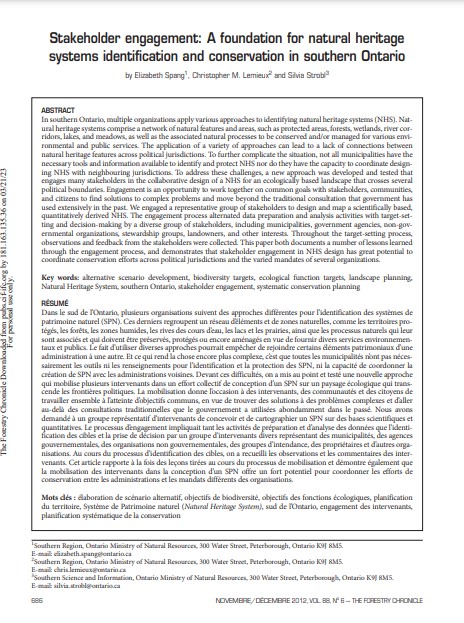Stakeholder engagement: A foundation for natural heritage systems identification and conservation in southern Ontario.
Bosque Modelo:
Eastern Ontario
Temática:
Participación social
Tipo de documento:
Artículo científico
Resumen
In southern Ontario, multiple organizations apply various approachesto identifying natural heritage systems(NHS). Natural heritage systems comprise a network of natural features and areas,such as protected areas, forests, wetlands, river corridors, lakes, and meadows, as well as the associated natural processes to be conserved and/or managed for various environmental and public services. The application of a variety of approaches can lead to a lack of connections between natural heritage features across political jurisdictions. To further complicate the situation, not all municipalities have the necessary tools and information available to identify and protect NHS nor do they have the capacity to coordinate designing NHS with neighbouring jurisdictions. To address these challenges, a new approach was developed and tested that engages many stakeholders in the collaborative design of a NHS for an ecologically based landscape that crosses several political boundaries. Engagement is an opportunity to work together on common goals with stakeholders, communities, and citizens to find solutions to complex problems and move beyond the traditional consultation that government has used extensively in the past. We engaged a representative group of stakeholders to design and map a scientifically based, quantitatively derived NHS. The engagement process alternated data preparation and analysis activities with target-setting and decision-making by a diverse group of stakeholders, including municipalities, government agencies, non-governmental organizations, stewardship groups, landowners, and other interests. Throughout the target-setting process, observations and feedback from the stakeholders were collected. This paper both documents a number of lessons learned through the engagement process, and demonstrates that stakeholder engagement in NHS design has great potential to coordinate conservation efforts across political jurisdictions and the varied mandates of several organizations.
Información Bibliográfica
Autor:
Spang, E., Lemieux, C. M., & Strobl, S.
Revista:
The Forestry Chronicle
Año:
2012
N°:
6
País :
Canadá
Páginas:
686 - 696
Volumen:
88
Idioma:
Ingles
Palabras claves
alternative scenario development, biodiversity targets, ecological function targets, landscape planning, Natural Heritage System, southern Ontario, stakeholder engagement, systematic conservation planning





